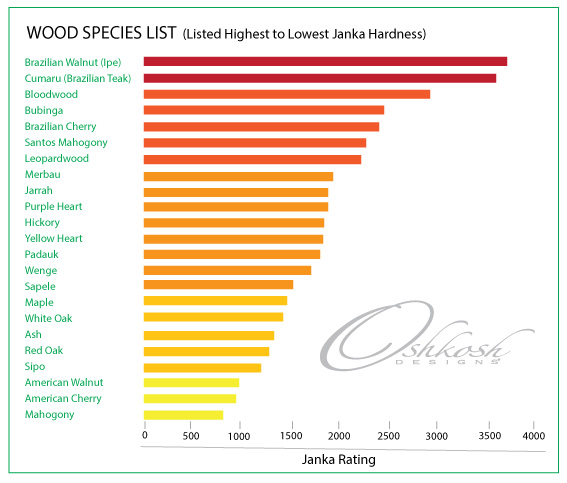The Janka hardness scale, or Janka rating, is a standardized, industrywide measurement of the relative hardness of an individual species of wood. This number is a simple, but useful, way to quickly determine how resistant a particular wood might be to scratches, dents and general wear. It also provides a clue as to how easy or difficult it may be to cut, sand or nail a given wood species.
Why Janka?
Named after Gabriel Janka, an Austrian who worked for the Forest Products Lab of the U.S. Department of Agriculture (USDA), the test was originally developed in 1906 when he was tasked by the USDA to develop a system for rating the hardness of American woods. Borrowing a page from the industrial engineering sector, which uses similar tests to determine the hardness of a wide variety of materials, Janka created a standardized, repeatable test that became the worldwide benchmark for analyzing wood’s resistance to denting and wear.
How Does It Work?
Essentially, the Janka rating is a measurement of the amount of force required to create a 200 sq mm indentation on the surface of the wood. The following steps illustrate how this is determined. The test begins with a 2 X 2 X 6 sample plank of the wood to be tested. The trial plank must be solid, unfinished and knot-free, with an approximate moisture content of 12%. Next, a 11.28 mm (.444 in) steel ball is placed on the sample, and a precisely measured (in lbs), increasing amount of force is applied until the ball is imbedded half-way into the wood, leaving a 200 sq mm indentation. The process is repeated on a different part of the same sample, and the results are averaged, to determine the overall Janka rating.
What Does This Mean For My Floor?
With hardness ratings running the gamut of values from 100 to over 4000, what is considered a good number for hardwood floors? As a general guideline, wood species used for flooring should have a Janka rating of around 1000 or higher. Another thing to consider is that the Janka test is performed on un-treated wood with a moisture level of around 12%. Hardwood that is installed will have a moisture content closer to 6-9%, and will have the benefit of being treated with multiple layers of protective coating.
While the Janka scale is an excellent tool in helping determine the appropriate wood for a given floor, it is only a part of the equation. It does provide some insight as to how well your floor will stand up to traffic, furniture, pets, and life in general. However, aesthetics, such as color, grain pattern, finish, and the overall look and feel of the room as a whole, are ultimately the driving factors with which we choose flooring. At the end of the day, no floor will be completely impervious to damage. Simple things such as using rugs in high traffic areas and performing routine care and maintenance will go a long way towards keeping whichever hardwood floors you choose beautiful for a long time to come.

